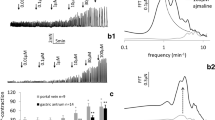Abstract
Angiotensin II and its natural fragment (des-aspartic acid)1-angiotensin II (angiotensin III) induced a dose-dependent contraction in the isolated rat stomach fundus strip and rat colon. 1-Acetyl-2-(8-chloro-10,11-dihydrodibenz(b,f)(1,4)oxazepine-10, carbonyl) hydrazine (SC 19220), a widely used competitive blocker of prostaglandins and acetyl salicyclic acid, a well-known inhibitor of prostaglandin biosynthesis, partially abolished the contraction induced by both peptides in the rat stomach fundus but not in the rat colon. The inhibition induced by SC 19220 and acetyl salicyclic acid was found to be higher for angiotensin III than angiotensin II when the dose-response curves and equipotent concentrations of the peptides were compared before and after the drugs.
These results were taken as evidence that some component of the contractile effects of angiotensin II and angiotensin III on the isolated rat stomach fundus involves the release of prastaglandins by the peptides and in this respect angiotensin III has higher potency than angiotensin II.
Similar content being viewed by others
References
J.R. McGiff, K. Crowshaw, N.A. Terragno andA.J. Lonigro,Release of Prostaglandin-like Substance into Renal Venous Blood in Response to Angiotensin II, Cir. Res.26–27, suppl., 1–121, 1–130 (1970).
S.H. Ferreira, S. Moncada andJ.R. Vane,Prostaglandins and the Mechanism of Analgesia Produced by Aspirin-like Drugs, Br. J. Pharmac.49, 86–97 (1973).
P. Peskar andG. Hertting,Release of Prostaglandins from Isolated Cat Spleen by Angiotensin and Vasopressin, Naunyn-Schmiedeberg's Arch. Pharmacol.279, 277–274 (1973).
S.H. Ferreira, S. Moncada andJ.R. Vane,Indomethacin and Aspirin Abolish Prostaglandin Release from the Spleen, Nature (Lond.)231, 237–239 (1971).
S.H. Ferreira, A. Herman andJ.R. Vane,Prostaglandin Generation Maintains the Smooth Muscle Tone of the Rabbit Isolated Jejunum, Br. J. Pharmac.44, 328–329 (1972).
A. Blumberg, S. Denny, K. Nishikawa, E. Pure, G.R. Marshall andP. Needleman,Angiotensin III-Induced Prostaglandin (PG) Release, Prostaglandins11, 195–197 (1976).
J.R. Blair-West, J.P. Coghlan, D.A. Denton, J.W. Funden, B.A. Scoggins andR.D. Wright,The Effect of the Heptapeptide (2–8) and Hexapeptide (3–8) Fragments of Angiotensin II on Aldosterone Secretion, J. Clin. Endoc. Metab.32, 575–578 (1971).
M.J. Peach andJ.A. Ackerly,Angiotensin Antagonists and the Adrenal Cortex and Medulla, Fed. Proc.35, N. 13, 2502–2507 (1976).
F. Coceani, C. Pace-Asciak, F. Volta andL.S. Wolfe,Effect of Nerve Stimulation on Prostaglandin Formation and Release from Rat Stomach, Am. J. Physiol.213, 1056–1064 (1967).
D. Regoli andJ.R. Vane,A Sensitive Method for the Assay of Angiotensin, Br. J. Pharmac.23, 351–359 (1964).
J.R. Vane,A Sensitive Method for the Assay of 5-Hydroxytryptamine, Br. J. Pharmac.13, 344–349 (1957).
J.H. Sanner,Antagonism of Prostaglandin E 2 by 1-Acetyl-2-(8-chloro-10,11-dihydrodibenz(b,f)(1,4)-oxazepine-10-carbonyl) Hydrazine (SC 19220), Arch. int. Pharmacodyn.180, 46–56 (1969).
J.R. Vane,Inhibition of Prostaglandin Synthesis as a Mechanism of Action for Aspirin-like Drugs, Nature New Biol.231, 232–235 (1971).
R.K. Türker, M. Yamamoto, P.A. Khairallah andF.M. Bumpus,Competetive Antagonism of 8-Ala-angiotensin II to Angiotensin I and II on Isolated Rabbit Aorta and Rat Ascending Colon, Eur. J. Pharmac.15, 285–291 (1971).
E.K.S. Chong andO.A. Downing,Reversal of Prostaglandin E 2 of the Inhibitory Effect of Indomethacin on Contractions of Guinea-pig Ileum Induced by Angiotensin, J. Pharm. Pharmac.26, 729–730 (1974).
E.K.S. Chong andO.A. Downing,Selective Inhibition of Angiotensin-Induced Contractions of Smooth Muscle by Indomethacin, J. Pharm. Pharmac.25, 170–171 (1973).
D. Regoli, W.K. Park andF. Rioux Pharmacology of Angiotensin, Pharmac. Rev.26, 69–123 (1974).
Author information
Authors and Affiliations
Additional information
This work is supported by a grant from the Turkish Scientific and Technical Research Council (TAG-350).
Rights and permissions
About this article
Cite this article
Ercan, Z.S., Türker, R.K. A comparison between the prostaglandin releasing effects of angiotensin II and angiotensin III. Agents and Actions 7, 569–572 (1977). https://doi.org/10.1007/BF02111131
Received:
Issue Date:
DOI: https://doi.org/10.1007/BF02111131




